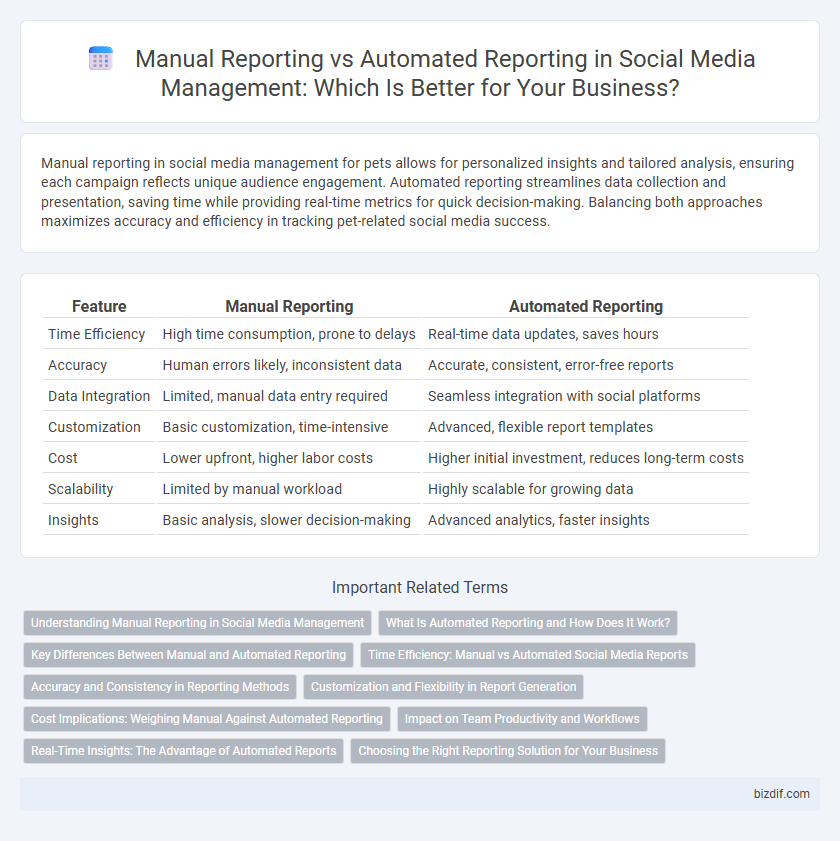Manual reporting in social media management for pets allows for personalized insights and tailored analysis, ensuring each campaign reflects unique audience engagement. Automated reporting streamlines data collection and presentation, saving time while providing real-time metrics for quick decision-making. Balancing both approaches maximizes accuracy and efficiency in tracking pet-related social media success.
Table of Comparison
| Feature | Manual Reporting | Automated Reporting |
|---|---|---|
| Time Efficiency | High time consumption, prone to delays | Real-time data updates, saves hours |
| Accuracy | Human errors likely, inconsistent data | Accurate, consistent, error-free reports |
| Data Integration | Limited, manual data entry required | Seamless integration with social platforms |
| Customization | Basic customization, time-intensive | Advanced, flexible report templates |
| Cost | Lower upfront, higher labor costs | Higher initial investment, reduces long-term costs |
| Scalability | Limited by manual workload | Highly scalable for growing data |
| Insights | Basic analysis, slower decision-making | Advanced analytics, faster insights |
Understanding Manual Reporting in Social Media Management
Manual reporting in social media management involves the hands-on collection and analysis of data from various platforms, ensuring customized insights tailored to specific campaign goals. This process allows for nuanced interpretation of metrics such as engagement rates, follower growth, and content performance, although it is time-intensive and prone to human error. Understanding manual reporting helps marketers maintain control over data accuracy and contextual relevance before transitioning to more efficient automated reporting tools.
What Is Automated Reporting and How Does It Work?
Automated reporting in social media management uses software tools to collect, analyze, and visualize data from various platforms without manual input, saving time and reducing human error. It operates by integrating APIs from social networks to gather metrics such as engagement rates, follower growth, and campaign performance in real-time. This process enables marketers to generate consistent, accurate reports quickly, facilitating data-driven decision-making and strategy optimization.
Key Differences Between Manual and Automated Reporting
Manual reporting requires users to collect, analyze, and compile social media data manually, which can be time-consuming and prone to human error. Automated reporting uses software tools to gather and process data in real-time, providing consistent updates and reducing the risk of inaccuracies. Key differences include speed, accuracy, scalability, and the ability to customize reports based on dynamic social media metrics.
Time Efficiency: Manual vs Automated Social Media Reports
Automated social media reporting significantly enhances time efficiency by instantly compiling data from multiple platforms, eliminating the need for manual data collection and entry. Manual reporting often requires hours of labor-intensive processes, increasing the risk of errors and inconsistent data interpretation. Tools like Hootsuite Analytics and Sprout Social automate data aggregation and visualization, enabling quicker strategic decisions.
Accuracy and Consistency in Reporting Methods
Manual reporting in social media management often leads to inconsistencies and human errors, affecting the accuracy of performance data. Automated reporting tools use algorithms and real-time data integration to ensure precise and consistent metrics across campaigns. Consistent reporting methods improve decision-making by providing reliable insights into engagement rates, follower growth, and content effectiveness.
Customization and Flexibility in Report Generation
Manual reporting offers unparalleled customization and flexibility in social media management by allowing users to tailor report metrics and formats to specific campaign goals, audience segments, and performance indicators. In contrast, automated reporting streamlines data compilation and delivers consistent results but may limit the ability to adjust parameters or include bespoke metrics unique to a brand's strategy. Choosing manual reporting ensures granular control over content and presentation, making it ideal for detailed analysis and strategic decision-making.
Cost Implications: Weighing Manual Against Automated Reporting
Manual social media reporting often incurs higher labor costs due to time-intensive data collection and analysis, limiting scalability for growing businesses. Automated reporting tools reduce expenses by streamlining data aggregation and generating real-time insights with minimal human intervention. Investing in automation enhances cost efficiency while maintaining accuracy and freeing resources for strategic initiatives.
Impact on Team Productivity and Workflows
Manual reporting in social media management often leads to time-consuming data collection and increased chances of human error, which slows team productivity and disrupts workflows. Automated reporting streamlines data aggregation and analysis, enabling quicker insights and allowing teams to focus on strategic tasks rather than routine data preparation. Integrating automated reporting tools reduces workload, accelerates decision-making processes, and enhances overall efficiency in managing social media campaigns.
Real-Time Insights: The Advantage of Automated Reports
Automated reporting in social media management delivers real-time insights by instantly aggregating data from multiple platforms, enabling swift decision-making and strategy adjustments. Manual reporting often suffers from delays and human error, which can hinder timely responses to trending topics or campaign performance changes. Real-time automated reports enhance precision and responsiveness, driving more effective engagement and ROI optimization.
Choosing the Right Reporting Solution for Your Business
Selecting the optimal reporting solution for social media management hinges on the specific needs of your business, balancing accuracy with efficiency. Manual reporting allows for tailored insights and nuanced analysis but demands significant time and resources, making it ideal for small-scale campaigns or specialized metrics. Automated reporting streamlines data collection from platforms like Facebook Insights and Twitter Analytics, delivering real-time dashboards and consistent metrics that support scalable and data-driven decision-making.
manual reporting vs automated reporting Infographic

 bizdif.com
bizdif.com